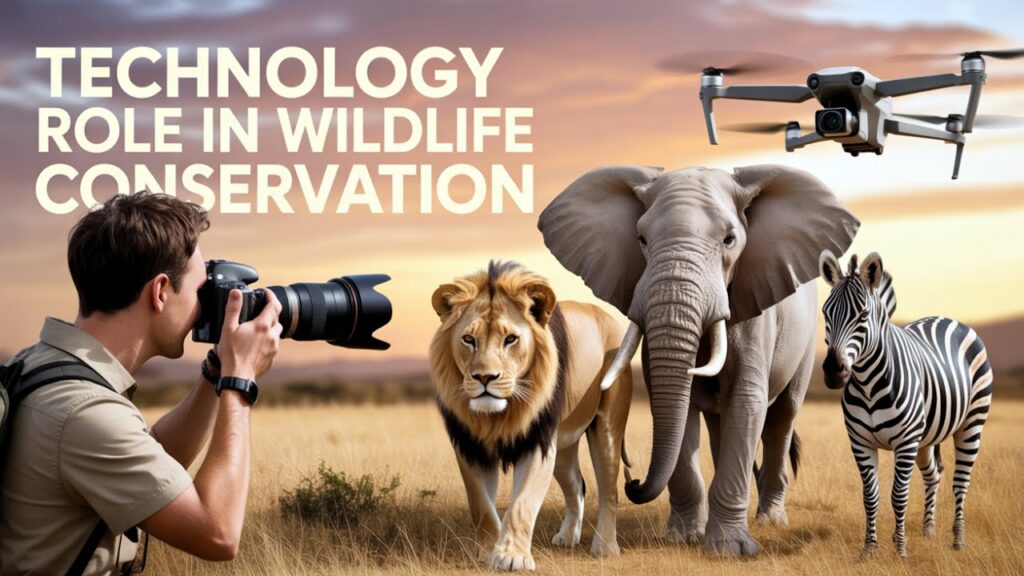The field of wildlife conservation is undergoing a profound transformation, driven by the rapid advancement of technology and innovation.1 These new tools are revolutionizing how we monitor, protect, and understand the natural world, offering unprecedented opportunities to address the escalating threats to biodiversity.
Current Technological Applications in Wildlife Conservation
A wide array of technologies are already in use, providing conservationists with powerful tools to collect data, combat illegal activities, and manage habitats.
- Drones and Remote Sensing: Drones equipped with high-resolution cameras, thermal imaging, and other sensors are used for a variety of tasks, including:
- Anti-Poaching Efforts: Drones provide real-time surveillance of remote areas, detecting poachers and alerting rangers to potential threats.
- Habitat Monitoring: They can map and assess the health of large ecosystems, track deforestation, and identify critical habitats.
- Population Surveys: Drones can be used to count animal populations, especially in challenging terrains like dense forests or hard-to-reach nesting sites
- GPS and Satellite Tracking: GPS collars and satellite tags are attached to animals to monitor their movements, migration patterns, and behavior. This data helps scientists:
- Identify Critical Habitats: Pinpoint important stopover sites and migration corridors that require protection.
- Mitigate Human-Wildlife Conflict: Track animals’ proximity to human settlements and agricultural areas, allowing for proactive measures to prevent conflicts.
- Camera Traps: These motion-activated cameras have been a staple in conservation for years.9 They provide a non-invasive way to study elusive species and collect data on population size, behavior, and interspecies interactions.
- Data Analysis with AI: Machine learning and computer vision are now used to rapidly analyze the vast number of images collected by camera traps, identifying species and individuals much faster than human researche
- Acoustic Monitoring: Acoustic sensors are deployed in the field to passively record sounds. This technology is particularly useful for monitoring vocal species like birds, bats, and marine mammals.
- AI-Powered Analysis: AI algorithms can sift through hours of audio to identify specific animal calls, pinpointing species presence, estimating population density, and even detecting human disturbances like gunshots or vehicles.
- Environmental DNA (eDNA): This innovative technique involves collecting DNA from environmental samples like water, soil, or air.14 By analyzing the eDNA, scientists can determine which species have recently been in an area without ever having to see or capture them.
- Biodiversity Assessments: A single water sample can provide a snapshot of the dozens of species living in an aquatic ecosyst
The Future of Wildlife Conservation Technology
The ongoing development of these technologies points toward a future where conservation efforts are more efficient, data-driven, and globally connected.
- Advanced AI and Predictive Modeling: The role of AI is expected to expand dramatically. Beyond simple image or sound analysis, future AI systems will be able to:
- Predict Poaching Hotspots: By analyzing historical data on poaching incidents, environmental factors, and animal movements, AI could help allocate resources to prevent crimes before they happen.
- Model Ecosystems: Create virtual simulations of ecosystems to forecast the effects of climate change, human development, or conservation interventions on wildlife populations.
- Miniaturization and Interconnectivity: As technology becomes smaller and more energy-efficient, we will see a new generation of tiny, networked sensors.
- Internet of Wild Things (IoWT): An interconnected network of sensors, cameras, and tracking devices will provide a comprehensive, real-time picture of an entire ecosystem.
- Genomics and Bio-banking: Advances in genetic analysis will allow conservationists to better understand population structures, genetic diversity, and disease susceptibility. Bio-banking of genetic material from endangered species will be crucial for potential future restoration efforts.
- Frugal Innovation and Open-Source Tools: The development of low-cost, open-source conservation technology will be essential for making these tools accessible to a wider range of conservationists, especially in developing nations where biodiversity is often most at risk.
Challenges and Opportunities
While the potential is immense, the integration of technology into conservation is not without its challenges.
- Cost and Accessibility: Many advanced technologies are expensive, creating a significant barrier for underfunded conservation projects.
- Data Overload: The sheer volume of data generated by these tools can be overwhelming, and there is a need for robust data management systems and trained personnel to analyze it.
- Ethical Concerns: The use of surveillance technology raises questions about data privacy, especially when monitoring areas inhabited by local communities. The potential for technology to disturb wildlife is also a concern.
- Capacity Building: There is a pressing need to train conservationists and local communities on how to use and maintain these new technologies effectively.
Despite these hurdles, the future of wildlife conservation is undeniably intertwined with technology. By fostering collaboration, increasing funding, and developing solutions that are both effective and accessible, we can harness the power of innovation to protect our planet’s precious biodiversity for generations to come.
